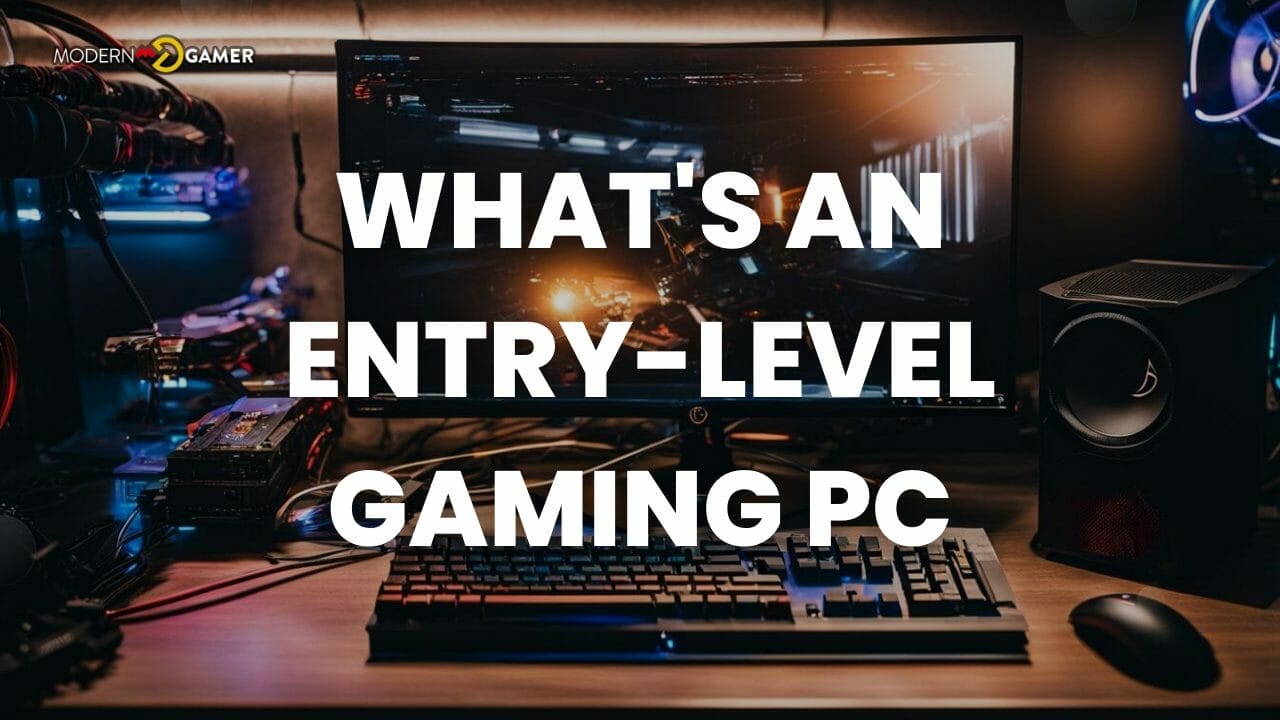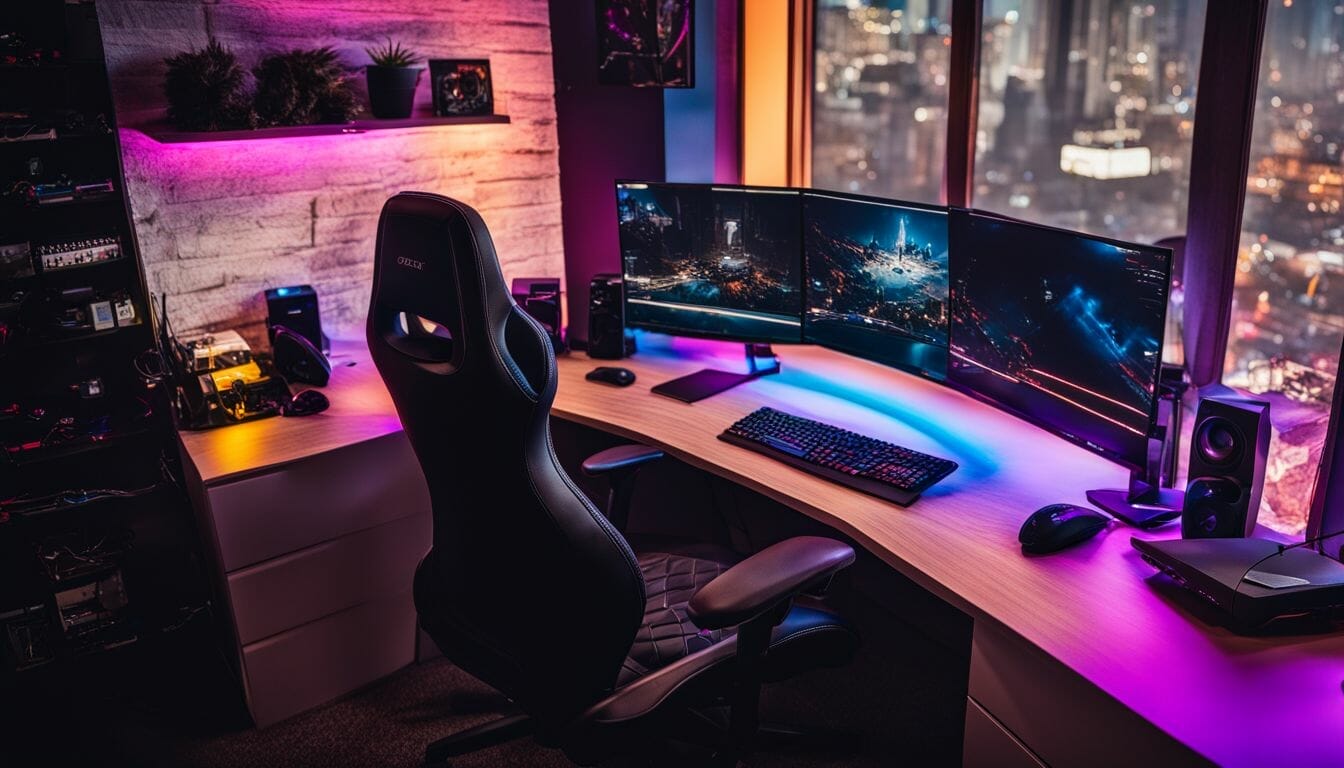The Beginner’s Best Friend: What’s an Entry-Level Gaming PC

Do you find the world of PC gaming intriguing, yet are intimidated by the complex setups and high costs associated with it? We’ve faced this obstacle too and empathize with the feeling of trepidation you may experience while navigating through the vast array of components on offer in the marketplace.
Rest assured, we have researched extensively and created an easy-to-follow guide on entry-level gaming PCs, focusing on what they are, their key features, considerations when choosing one as well as some popular options currently available.
Ready to begin your journey into PC gaming without breaking the bank? Dive in!
Key Takeaways
- An entry-level gaming PC is a budget-friendly computer designed for beginners or those on a tight budget who want to experience PC gaming.
- It offers decent performance and can run most games, although it may not handle more demanding titles at high settings.
- Key components include the processor (CPU), graphics card (GPU), memory (RAM), storage, and power supply.
- Considerations when choosing an entry – level gaming PC include price range and budget, desired gaming requirements and performance, future upgradability options, and brand reliability.
What is an Entry-Level Gaming PC?

An entry-level gaming PC is a budget-friendly computer designed specifically for gamers who are just starting out or have limited resources. It offers decent performance and meets the basic requirements to play most games, although it may not be able to handle more demanding titles at high settings.
Definition and purpose
An entry-level gaming PC is a basic computer made for playing games. It has enough power to run most games, but not as fast or pretty as a high-performance gaming PC. These computers are meant for gamers who are just starting out or who don’t want to spend too much money.
They give people the chance to enjoy their favorite games without having to pay so much money right away. In time, they can upgrade it with better parts if they want. So an entry-level gaming PC is like your first step into the world of computer gaming.
Specifications and performance expectations
An entry-level gaming PC is more than a basic computer. It gives us better play with its smooth moves and sharp pictures. It doesn’t hold back or slow down as others do. The power inside it can change from one model to the next.
Yet, all of them have strong cores, high tech picture show cards, and plenty of memory space. These are what make the games come alive on our screens! Most people spend between $600 to $800 for a good PC fit for 1080p games.
But remember, each game asks for something different from your PC’s parts like its graphics card and other pieces inside it.
Key Components of an Entry-Level Gaming PC

The key components of an entry-level gaming PC include the processor (CPU), graphics card (GPU), memory (RAM), storage, and power supply.
Processor (CPU)
The processor, or CPU, is the brain of our gaming PC. It runs tasks and does complex math. For good game play, the CPU needs to be strong. We look at its core count when we choose one for a gaming PC.
A CPU with many cores works well in an entry-level gaming PC because it can do many things at once.
Graphics Card (GPU)
The graphics card, also known as the GPU or video card, is a crucial component of an entry-level gaming PC. Its primary job is to create all the images and graphics you see on your computer screen when playing games.
The graphics card has its own processor called the GPU, which handles the complex calculations needed to render and display these graphics. It connects to the motherboard for data and power, allowing it to communicate with other parts of your PC.
Popular manufacturers like Nvidia and AMD make GPUs for graphics cards. If you want better gaming performance, upgrading your graphics card can make a big difference.
Memory (RAM)
RAM, or random access memory, is a really important part of an entry-level gaming PC. It’s like the computer’s short-term memory that helps it run smoothly and quickly. When you play games on your PC, RAM helps to load all the game data so that everything runs smoothly without any lag.
The amount of RAM you need for gaming depends on what you’re going to do with your PC. If you’re just using it for everyday stuff like browsing the internet and watching videos, 8GB of RAM should be enough.
But if you’re into serious gaming or creating multimedia content, then you might need more RAM – somewhere between 16GB and 64GB! Adding more RAM to your gaming PC can make it faster and improve how well games run on it.
Storage
Storage is a really important part of an entry-level gaming PC. It’s where you keep all your games, files, and everything else. There are different types of storage options you can choose from.
One common option is a hard drive, which has more space but might be a bit slower. Another option is an SSD (Solid State Drive), which is faster but usually has less space. Entry-level gaming PCs often come with smaller storage capacities compared to fancier models, but the good news is that you can usually add more storage later if you need it.
So don’t worry too much about having tons of storage right away – just make sure you have enough for your games and other stuff!
Power Supply
The power supply is a key component of an entry-level gaming PC. It’s responsible for providing electricity to all the other parts, like the processor and graphics card. When choosing a power supply, you need to consider its wattage, which determines how much power it can handle.
Most entry-level gaming PCs require at least 450W, but this can vary depending on factors like the components you have and how much power they consume. A good rule of thumb is to get a power supply unit between 500 and 550 watts, as this should be suitable for most people’s needs.
Keep in mind that the total wattage of your PC will include around 20% extra due to the power supply unit itself. Also, make sure that any power supply unit you choose follows the Entry-Level Power Supply Specification (EPS).
Considerations When Choosing an Entry-Level Gaming PC
When choosing an entry-level gaming PC, it is important to consider factors such as price range and budget, desired gaming requirements and performance, future upgradability options, and the brand’s reliability.
Price range and budget
When it comes to buying an entry-level gaming PC, the price range and your budget are important considerations. Most of these computers cost less than $1,000, making them affordable for gamers on a budget.
However, keep in mind that the performance of the PC will also depend on how much you’re willing to spend. If you can invest around $400 or more, you’ll be able to get a decent GPU for gaming.
On the other hand, if you’re looking for a mid-level gaming PC with better specs, expect to pay between $1,000 and $2,000. High-end gaming PCs can even cost more than $2,000. So think about your budget and what kind of gaming experience you want before making a decision.
In conclusion:
– Entry-level gaming PCs typically cost less than $1,000.
– Investing around $400 or more can get you a decent GPU.
Gaming requirements and desired performance
As gamers, we all want our gaming experience to be smooth and enjoyable. To achieve that, it’s important to consider the gaming requirements and desired performance when choosing an entry-level gaming PC.
Modern computer games have high-speed action and realistic graphics, so you’ll need a capable gaming PC to keep up.
One of the key components you should pay attention to is the graphics card, or GPU. A dedicated GPU is ideal for playing most modern games, as it can handle the demanding visuals and deliver smooth gameplay.
Make sure your chosen gaming PC has a graphics card that meets or exceeds the recommended requirements for your favorite games.
Another important component is the processor, or CPU, along with sufficient RAM (random access memory). These two work together to ensure your games run smoothly without any lag or slowdowns.
Future upgradability
Upgradability is an important factor to consider when choosing an entry-level gaming PC. The great thing about gaming desktops is that they provide the opportunity for future upgrades.
This means that even if your current system may not have all the top-of-the-line components, you can always enhance and customize it over time. From adding more RAM to upgrading your graphics card or even swapping out your processor, there are plenty of ways to improve the performance and capabilities of your PC as technology evolves.
So, when looking at entry-level options, it’s crucial to think about expandability, compatibility, and scalability to ensure that you’ll be able to adapt and evolve with future advancements in the gaming world.
Brand and reliability
When choosing an entry-level gaming PC, it’s important to consider the brand and reliability. We should research user reviews and feedback to get insights into a brand’s reputation and reliability.
By comparing prices, warranties, and customer support services, we can evaluate the reliability of different brands. This will help us make an informed decision and ensure that our entry-level gaming PC is dependable for our gaming needs.
Popular Entry-Level Gaming PC Options
Here are some of the top entry-level gaming PCs in the market that offer great performance without breaking the bank.
Top brands and models in the market
We’ve researched the top brands and models in the market to help you find the best entry-level gaming PC that suits your needs. Here are some popular options for you to consider:
- HP Pavilion Gaming Desktop: HP is known for producing gaming PCs that cater to both advanced and entry-level gamers. The Pavilion Gaming Desktop offers a great balance of performance and affordability.
- Dell G5 Gaming Desktop: Dell’s G5 Gaming Desktop is another top choice in the market. It boasts powerful hardware, including high-performance processors and graphics cards, making it ideal for intense gaming sessions.
- Lenovo Legion T5: Lenovo’s Legion series has gained popularity among gamers, and the Legion T5 model doesn’t disappoint. It combines sleek design with impressive performance, making it a reliable option for entry-level gamers.
- Acer Nitro 50: Acer’s Nitro 50 offers an affordable gaming experience without compromising on performance. With its powerful processor and dedicated graphics card, it can handle most modern games with ease.
Features and specifications comparison
When looking at features and specifications, it’s important to compare different models to ensure you’re getting the best value for your money. Here are some popular entry-level gaming PCs and their key specifications.
| Model | CPU | GPU | RAM | Storage | Price |
|---|---|---|---|---|---|
| HP Pavilion Gaming Desktop | AMD Ryzen 5 3500 | NVIDIA GeForce GTX 1650 | 8GB DDR4 | 256GB SSD | Approx $730 |
| CyberPowerPC Gamer Xtreme VR | Intel Core i5-9400F | NVIDIA GeForce GTX 1660 | 8GB DDR4 | 240GB SSD + 1TB HDD | Approx $800 |
| Dell G5 Gaming Desktop | Intel Core i5-9400 | NVIDIA GeForce GTX 1660 Ti | 8GB DDR4 | 1TB HDD + 256GB SSD | Approx $930 |
These models give a good performance for their price and are reliable options for beginners in gaming. Always make sure to consider your specific needs and preferences when choosing a gaming PC.
Price range and value for money
When looking for an entry-level gaming PC, it’s important to consider the price range and value for money. These PCs typically cost between $500 and $800, offering a budget-friendly option for gamers.
For this price range, you can expect a decent gaming experience that can handle basic gaming needs. However, if you’re willing to spend a bit more, around $800 – $1,200, you can get a higher-end gaming PC with better graphics and performance.
Ultimately, it all comes down to your budget and the level of gaming experience you desire.
Conclusion
In conclusion, an entry-level gaming PC is a budget-friendly computer designed for beginners or those on a tight budget who want to experience the world of PC gaming. It may not have the highest specs or performance, but it can still deliver enjoyable gameplay and allow you to dive into your favorite games.
By considering factors like price range, desired performance, and future upgradability, you can find the perfect entry-level gaming PC that suits your needs and helps you embark on your gaming journey.
FAQs
1. What is an entry-level gaming PC?
An entry-level gaming PC is a computer system designed for playing video games that has lower specifications and performance compared to high-end gaming PCs.
2. What are the essential components of an entry-level gaming PC?
The essential components of an entry-level gaming PC include a processor, graphics card, memory (RAM), storage (hard drive or SSD), and power supply.
3. Can I upgrade an entry-level gaming PC in the future?
Yes, you can upgrade certain components of an entry-level gaming PC such as adding more RAM or replacing the graphics card to improve its performance over time.
4. How much does an entry-level gaming PC cost?
The cost of an entry-level gaming PC can vary depending on the specific components and brands chosen, but typically they range from $500 to $800.
5. What kind of games can be played on an entry-level gaming PC?
Entry-level gaming PCs are capable of running less demanding games at decent settings and framerates, including popular titles like Minecraft, League of Legends, or Fortnite.

